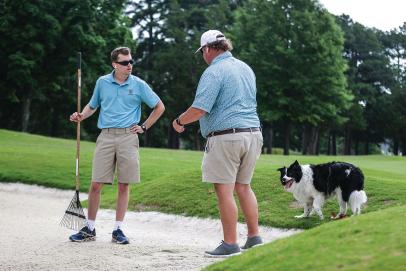Ask a super: Should I leave bunker rakes inside or outside the sand? – Australian Golf Digest

- by Admin
- September 11, 2024

Nearly every golfer understands it’s their responsibility to rake a bunker after they hit from it, but what should they do after that? Should they leave the rake inside or outside the bunker?
That’s the question we put to Shannon Wheeler, the director of agronomy at The Plantation at Ponte Vedra Beach. Wheeler has worked at The Plantation for about four years after serving as the superintendent at the nearby Dye’s Valley course at TPC Sawgrass.
Golf Digest: Shannon, where should golfers place bunker rakes?
Wheeler: The main thing is that the USGA recommends they go outside and out of the way. With a tour event, you’ve got a lot less rakes on the golf course and so generally they would place them outside the field of play. No matter if it’s a fairway bunker or greenside bunker, the rakes at an event will always be outside the bunker and not in line with where your shot and the hole would be.
But we tend not to put them completely outside of the field of play during recreational rounds just because the ease of the member or the player getting to the rake. You want to make it easy to keep play going, but also we tend to have way more rakes out than we would if you had an actual event. So, out of the way and equidistant apart is what we like.
I like them out of the bunker and the primary reason is, and I joke with our members, they should be out of the bunker because the handle is green. So you don’t see them.
But the real reason is we only touch the outside areas of a bunker once or twice a week, depending on season. During the off season, we might only mow it once a week or we might not even mow it at all. During growing season, we can sometimes mow those areas twice a week.
The rakes get moved around enough from the membership using them during the day that we don’t see any areas where the grass has a depression or the yellow underneath them.
More from Golf Digest Course maintenance A day for thanking golf course superintendents should also be about understanding what they do
Yeah, that’s a good point. What advice would you have for golfers on where they should enter the bunker to play a shot?

LarsZahnerPhotography
Wheeler: Typically, if I’m in a bunker, I walk and grab the rake then walk back to the shortest point of entrance to get into my ball. That’s a big thing. Some bunkers are a nightmare to get in and out of, so it’s important to go to the easiest point of entrance and exit. Don’t walk in on a lip because if you’re in a soft sea, you could collapse a bunker edge by walking on it.
If the rake is left in the bunker, though, I’m possibly walking through more of the bunker to get the rake, and so I’ve got more sand to rake.
You’re making it harder on yourself. Anything else worth mentioning?
Wheeler: All in all, at the end of the day, I just want players to rake the bunker. That’s the biggest challenge is actually using the rake. We see it from time to time, I’m serious. If you don’t have lifelong golfers, then sometimes those players think it’s our job on the maintenance staff.
We put a notice out every six months or so from the green committee saying, “Hey, remember to fix your ball marks, rake your bunkers, fill your divots.” It’s always a moving target.
(The above conversation has been lightly edited for clarity and concision.)
More from Golf Digest  Golf Digest Logo The 15 hottest courses in America, according to our experts
Golf Digest Logo The 15 hottest courses in America, according to our experts
MORE ASK A SUPER:
How courses prep for high-level competition, according to top USGA experts
Why are practice greens slower than greens on the course?
Why’s the grass all brown on our course?
Why are you aerating our greens when they’re in perfect shape?
I repaired my ball mark, but it still doesn’t look right. What did I do wrong?
We all want fast greens, why can’t you just cut them shorter?
Why your superintendent is hoping for lots of snow this winter
Aerating greens, explained by a top course superintendent
This article was originally published on golfdigest.com
The Latest News
-
January 4, 2025Horse Racing News: Holymanz strikes again at Geelong races
-
January 4, 2025Australia coach calls out ‘intimidating’ India celebrations, reveals Konstas chat
-
January 4, 2025Wife’s brutal reaction as Steve Smith savaged over ‘selfish’ act against teammate
-
January 4, 2025Bumrah under cloud as India reveal back spasm | cricket.com.au
-
January 4, 2025Biggest curveball of summer that could decide series; Beau ‘earns his stripes’ in coming of age: Talking Pts




